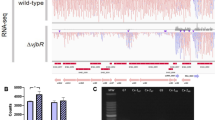Abstract
YvcPQ is one of the two-component signal transduction systems that respond to specific stimuli and enable cells to adjust multiple cellular functions. It consists of a histidine kinase YvcQ and a response regulator YvcP. In this study, through searching the consensus sequence recognized by YvcP, we found four YvcP-binding motifs in the promoter regions of genes yvcR (BMB171_C4100), BMB171_C4385, kapD (BMB171_C4525) and BMB171_C4835 in Bacillus thuringiensis BMB171 which is a representative of Bacillus cereus group, and confirmed that these genes are regulated by YvcP. We compared the sequence of yvcPQ and its downstream genes in genus Bacillus, and found two different kinds of yvc locus, one was the yvcPQ-RS in B. subtilis species and the other was the yvcPQ-R-S1S2 in B. cereus group. Furthermore, we found that YvcP activates the transcription of yvcS1S2 (downstream of yvcR) to promote bacterial resistance to bacitracin and deletion of either yvcPQ operon or yvcS1S2 operon renders the bacterial cells more sensitive to bacitracin. This study enriched our understanding of both the YvcPQ’s function and the mechanism of bacterial resistance to bacitracin.





Similar content being viewed by others
References
Bouillaut L, Ramarao N, Buisson C, Gilois N, Gohar M, Lereclus D, Nielsen-Leroux C (2005) FlhA influences Bacillus thuringiensis PlcR-regulated gene transcription, protein production, and virulence. Appl Environ Microbiol 71:8903–8910
Bourret BR, Silversmith ER (2010) Two-component signal transduction. Curr Opin Microbiol 13:113–115
Cheung J, Hendrickson AW (2010) Sensor domains of two-component regulatory systems. Curr Opin Microbiol 13:116–123
de Been M, Bart MJ, Abee T, Siezen RJ, Francke C (2008) The identification of response regulator-specific binding sites reveals new roles of two-component systems in Bacillus cereus and closely related low-GC Gram-positives. Environ Microbiol 10:2796–2809
Guo M, Feng H, Zhang J, Wang W, Wang Y, Li Y, Gao C, Chen H, Feng Y, He ZG (2009) Dissecting transcription regulatory pathways through a new bacterial one-hybrid reporter system. Genome Res 19:1301–1308
He J, Shao X, Zheng H, Li M, Wang J, Zhang Q, Li L, Liu Z, Sun M, Wang S, Yu Z (2010) Complete genome sequence of Bacillus thuringiensismutant strain BMB171. J Bacteriol 192:4074–4075
Janes KB, Stibitz S (2006) Routine markerless gene replacement in Bacillus anthracis. Infect Immun 74:1949–1953
Kim MJ, Han JK, Park JS, Lee JS, Lee SH, Cho JI, Kim KS (2015) Various enterotoxin and other virulence factor genes widespread among Bacillus cereus and Bacillus thuringiensis strains. J Microbiol Biotechnol 25:872–879
Laub MT, Goulian M (2007) Specificity in two-component signal transduction pathways. Annu Rev Genet 41:121–145
Li L, Yang C, Liu Z, Li F, Yu Z (2000) Screening of acrystalliferous mutants from Bacillus thuringiensis and their transformation properties. Wei Sheng Wu Xue Bao 40:85–90 (in Chinese)
Mascher T, Margulis NG, Wang T, Ye RW, Helmann JD (2003) Cell wall stress responses in Bacillus subtilis: the regulatory network of the bacitracin stimulon. Mol Microbiol 50:1591–1604
Mei H, Tang Q, Li XF, Wang YX, Wang JP, He J (2015) Insights into sRNA genes regulated by two-component systems in the Bacillus cereus group. Curr Bioinform 10:456–468
Miller DA, Suen G, Clements KD, Angert ER (2012) The genomic basis for the evolution of a novel form of cellular reproduction in the bacterium Epulopiscium. BMC Genom 13:265
Ouyang J, Tian X, Versey J, Wishart A, Li Y (2010) The BceABRS four-component system regulates the bacitracin-induced cell envelope stress response in Streptococcus mutans. Antimicrob Agents Chemother 54:3895–3906
Palomino JC, Martin A, Camacho M, Guerra H, Swings J, Portaels F (2002) Resazurin microtiter assay plate: simple and inexpensive method for detection of drug resistance in Mycobacterium tuberculosis. Antimicrob Agents Chemother 46:2720–2722
Podgornaia IA, Laub TM (2013) Determinants of specificity in two-component signal transduction. Curr Opin Microbiol 16:156–162
Procaccini A, Lunt B, Szurmant H, Hwa T, Weigt M (2011) Dissecting the specificity of protein–protein interaction in bacterial two-component signaling: orphans and crosstalks. PLoS ONE 6:e19729
Rietkötter E, Hoyer D, Mascher T (2008) Bacitracin sensing in Bacillus subtilis. Mol Microbiol 68:768–785
Roh JY, Liu Q, Choi JY, Wang Y, Shim HJ, Xu HG, Choi GJ, Kim JC, Je YH (2009) Construction of a recombinant Bacillus velezensis strain as an integrated control agent against plant diseases and insect pests. J Microbiol Biotechnol 19:1223–1229
Staroń A, Finkeisen ED, Mascher T (2011) Peptide antibiotic sensing and detoxification modules of Bacillus subtilis. Antimicrob Agents Chemother 55:515–525
Tang Q, Li X, Zou T, Zhang H, Wang Y, Gao R, Li Z, He J, Feng Y (2014) Mycobacterium smegmatis BioQ defines a new regulatory network for biotin metabolism. Mol Microbiol 94:1006–1023
Wang J, Ai X, Mei H, Fu Y, Chen B, Yu Z, He J (2013a) High-throughput identification of promoters and screening of highly active promoter-5′-UTR DNA region with different characteristics from Bacillus thuringiensis. PLoS ONE 8:e62960
Wang J, Mei H, Zheng C, Qian H, Cui C, Fu Y, Su J, Liu Z, Yu Z, He J (2013b) The metabolic regulation of sporulation and parasporal crystal formation in Bacillus thuringiensis revealed by transcriptomics and proteomics. Mol Cell Proteomics 12:1363–1376
Zhang S, Hu Y, Fan Q, Wang X, He J (2015) Two-component system YvqEC-dependent bacterial resistance against vancomycin in Bacillus thuringiensis. Antonie Van Leeuwenhoek 108:365–376
Zheng C, Ma Y, Wang X, Xie YQ, Ali MK, He J (2015) Functional analysis of the sporulation-specific diadenylate cyclase CdaS in Bacillus thuringiensis. Front Microbiol 6:908
Acknowledgments
This work was supported by the National Natural Science Foundation of China (Grant 31270105), the Fundamental Research Funds for the Central Universities (Grant 2662015PY175) and the National High-tech R&D Program of China (863 Program, Grant 2011AA10A205).
Author information
Authors and Affiliations
Corresponding author
Ethics declarations
Conflict of interest
The authors have no conflicts of interest.
Additional information
Communicated by Pierre Béguin.
Electronic supplementary material
Below is the link to the electronic supplementary material.
Rights and permissions
About this article
Cite this article
Zhang, S., Li, X., Wang, X. et al. The two-component signal transduction system YvcPQ regulates the bacterial resistance to bacitracin in Bacillus thuringiensis . Arch Microbiol 198, 773–784 (2016). https://doi.org/10.1007/s00203-016-1239-z
Received:
Revised:
Accepted:
Published:
Issue Date:
DOI: https://doi.org/10.1007/s00203-016-1239-z




